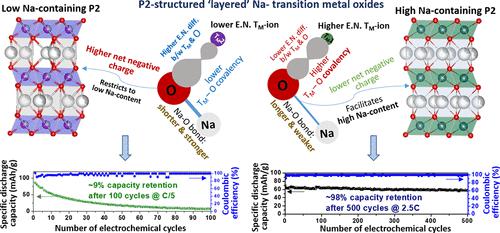当前位置:
X-MOL 学术
›
Chem. Mater.
›
论文详情
Our official English website, www.x-mol.net, welcomes your feedback! (Note: you will need to create a separate account there.)
Fundamental Principles toward Designing High Na-Containing P2-Structured “Layered” Na-Transition Metal Oxides as High-Performance Cathode Materials for Na-Ion Batteries
Chemistry of Materials ( IF 8.6 ) Pub Date : 2022-11-15 , DOI: 10.1021/acs.chemmater.2c02478 Bachu Sravan Kumar 1 , Rahul Kumar 2 , Anagha Pradeep 1 , Amardeep Amardeep 1 , Velaga Srihari 3 , Himanshu K. Poswal 3 , Abhijit Chatterjee 2 , Amartya Mukhopadhyay 1
Chemistry of Materials ( IF 8.6 ) Pub Date : 2022-11-15 , DOI: 10.1021/acs.chemmater.2c02478 Bachu Sravan Kumar 1 , Rahul Kumar 2 , Anagha Pradeep 1 , Amardeep Amardeep 1 , Velaga Srihari 3 , Himanshu K. Poswal 3 , Abhijit Chatterjee 2 , Amartya Mukhopadhyay 1
Affiliation

|
The present work proposes and establishes a universal strategy toward facilitating the development of desired structural types (viz., P-type vs O-type) of “layered” Na- transition metal (TM) oxides, with the desired Na-content and properties. In this regard, the structure type, allowable Na-content, and Na-layer/“inter-slab” spacing have been found to depend on the “charge:size” ratio of the TM-ions, concomitant electronegativity and covalency of TM–O bonds, and the charge neutrality aspect. Overall, increases in the average “charge:size” ratio of the cation combination in the TM-layer and concomitant TM–O bond covalency result in a lower effective negative charge on the O-ions. This renders the prismatic coordination of O-ions around the Na-ions more favorable even at a higher Na-content, but with the latter needing some compromise over the charge neutrality aspect. Accordingly, by careful selection of the combination of non-TM/TM-ions in the TM-layer, a high Na-containing (viz., ∼0.84 per formula unit) P2-type Na0.84([]0.06Li0.04Mg0.02Ni0.22Mn0.66)O2 has been successfully developed here, which, as a cathode material for Na-ion batteries, exhibits a high desodiation capacity of ∼178 mAh/g (@ C/5; within 2–4 V vs Na/Na+), exceptional cyclic stability pertaining to a ∼98% capacity retention after 500 galvanostatic desodiation/sodiation cycles at a high current density (2.5C), and also stability upon exposure to air/water. The suitable combination of a high Na-content and “charge:size” ratio in the TM-layer of the as-developed P2-type Na-TM-oxide is again the factor responsible for the above properties/performances. Furthermore, going with the proposed scientific basis, mere replacement of Mn4+, having a higher “charge:size” ratio (∼7.5 Å–1), with Ti4+, having a lower “charge:size” ratio (∼6.5 Å–1), keeping everything else the same, has been found to yield the O3-type structure.
中文翻译:

设计高含钠 P2 结构“层状”钠过渡金属氧化物作为钠离子电池高性能阴极材料的基本原理
目前的工作提出并建立了一种通用策略,以促进“层状”Na-过渡金属 ( TM ) 氧化物的所需结构类型(即P 型与 O 型)的开发,具有所需的 Na 含量和特性。在这方面,已发现结构类型、允许的 Na 含量和 Na 层/“层间”间距取决于 T M 离子的“电荷:尺寸”比、伴随的电负性和 T 的共价性M –O 键和电荷中性方面。总体而言,T M层和伴随的 T M中阳离子组合的平均“电荷:尺寸”比增加–O 键共价导致 O 离子上的有效负电荷较低。这使得 O 离子围绕 Na 离子的棱柱配位即使在较高的 Na 含量下也更加有利,但后者需要在电荷中性方面做出一些妥协。因此,通过仔细选择T M层中非 T M /T M离子的组合,高含钠量(即每个分子式单元约 0.84)P2 型 Na 0.84([] 0.06 Li 0.04镁0.02镍0.22锰0.66 )O 2已在这里成功开发,作为钠离子电池的阴极材料,表现出高脱钠能力~178 mAh/g(@ C/5;在 2–4 V vs Na/Na + 内),出色的循环稳定性在高电流密度 (2.5C) 下经过 500 次恒电流脱钠/钠化循环后,容量保持率约为 98%,并且在暴露于空气/水中时也具有稳定性。开发的 P2 型 Na-T M氧化物的 T M层中高 Na 含量和“电荷:尺寸”比的适当组合再次是造成上述特性/性能的因素。此外,根据所提出的科学依据,仅用 Ti 替换具有更高“电荷:尺寸”比 (∼7.5 Å –1 )的 Mn 4+4+具有较低的“电荷:尺寸”比率 (∼6.5 Å –1 ),保持其他一切不变,已被发现产生 O3 型结构。
更新日期:2022-11-15
中文翻译:

设计高含钠 P2 结构“层状”钠过渡金属氧化物作为钠离子电池高性能阴极材料的基本原理
目前的工作提出并建立了一种通用策略,以促进“层状”Na-过渡金属 ( TM ) 氧化物的所需结构类型(即P 型与 O 型)的开发,具有所需的 Na 含量和特性。在这方面,已发现结构类型、允许的 Na 含量和 Na 层/“层间”间距取决于 T M 离子的“电荷:尺寸”比、伴随的电负性和 T 的共价性M –O 键和电荷中性方面。总体而言,T M层和伴随的 T M中阳离子组合的平均“电荷:尺寸”比增加–O 键共价导致 O 离子上的有效负电荷较低。这使得 O 离子围绕 Na 离子的棱柱配位即使在较高的 Na 含量下也更加有利,但后者需要在电荷中性方面做出一些妥协。因此,通过仔细选择T M层中非 T M /T M离子的组合,高含钠量(即每个分子式单元约 0.84)P2 型 Na 0.84([] 0.06 Li 0.04镁0.02镍0.22锰0.66 )O 2已在这里成功开发,作为钠离子电池的阴极材料,表现出高脱钠能力~178 mAh/g(@ C/5;在 2–4 V vs Na/Na + 内),出色的循环稳定性在高电流密度 (2.5C) 下经过 500 次恒电流脱钠/钠化循环后,容量保持率约为 98%,并且在暴露于空气/水中时也具有稳定性。开发的 P2 型 Na-T M氧化物的 T M层中高 Na 含量和“电荷:尺寸”比的适当组合再次是造成上述特性/性能的因素。此外,根据所提出的科学依据,仅用 Ti 替换具有更高“电荷:尺寸”比 (∼7.5 Å –1 )的 Mn 4+4+具有较低的“电荷:尺寸”比率 (∼6.5 Å –1 ),保持其他一切不变,已被发现产生 O3 型结构。



























 京公网安备 11010802027423号
京公网安备 11010802027423号